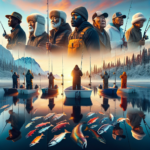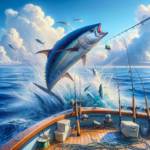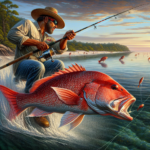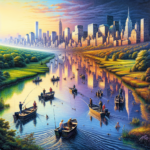Salmon Fishing in Alaska: Rivers, Lakes, and Coastal Waters

Introduction
Did you know that Alaska is home to some of the most prolific salmon fishing waters in the world, attracting anglers from all corners of the globe? Whether you’re a seasoned fisherman or a novice looking to experience the thrill of the catch, Alaska offers unparalleled opportunities to reel in various species of salmon. This article will delve into the intricacies of salmon fishing in Alaska, covering the best rivers, lakes, and coastal waters, the techniques to master, and the gear you’ll need to succeed.
Why does this matter? For many, fishing in Alaska is a bucket-list adventure, offering not just the chance to catch fish but to immerse oneself in the stunning natural beauty and rich cultural heritage of the region. Whether you’re planning a trip or simply curious about this fascinating topic, this guide will provide you with all the information you need to make the most of your Alaskan fishing experience.
Background/Context
Historical or Cultural Significance
Salmon fishing has been a cornerstone of Alaskan culture for thousands of years. Indigenous peoples relied on salmon as a primary food source, and the fish continues to play a vital role in the local economy and lifestyle. The annual salmon runs are not just a natural phenomenon but a cultural event, celebrated with festivals and community gatherings.
Geographical Overview
Alaska’s diverse geography includes vast rivers, pristine lakes, and extensive coastal waters, each offering unique fishing opportunities. The state’s climate varies from temperate rainforests in the southeast to arctic tundra in the north, creating a range of ecosystems that support different salmon species. Key fishing regions include the Kenai Peninsula, Bristol Bay, and the Inside Passage, each renowned for its abundant fish populations and breathtaking scenery.
Key Points/Details
Fishing Techniques
Technique Overview
Several fishing techniques are effective for catching salmon in Alaska, including fly fishing, trolling, and drift fishing. Fly fishing is particularly popular in rivers and streams, where anglers use artificial flies to mimic the insects that salmon feed on. Trolling involves dragging lures or bait behind a moving boat, making it ideal for coastal waters and large lakes. Drift fishing, where bait is allowed to drift naturally with the current, is another effective method, especially in rivers.
When and Where to Use
Fly fishing is best suited for rivers like the Kenai and the Russian River, especially during the summer months when salmon are actively spawning. Trolling is highly effective in coastal waters such as those around Kodiak Island and Prince William Sound. Drift fishing can be used in various rivers and streams, particularly during peak salmon runs in late summer and early fall.
Recommended Gear
- Fly Fishing: 9-10 foot fly rod, 8-10 weight fly reel, floating and sinking fly lines, and a variety of salmon flies.
- Trolling: Medium-heavy trolling rod, conventional reel with line counter, downriggers, and trolling lures such as spoons and hoochies.
- Drift Fishing: Medium-heavy spinning or baitcasting rod, spinning or baitcasting reel, drift rigs with weights, and bait such as salmon eggs or herring.
Species Information
Species Overview
Alaska is home to five main species of Pacific salmon: King (Chinook), Sockeye (Red), Coho (Silver), Pink (Humpy), and Chum (Dog). Each species has unique habits and preferred habitats. For example, King salmon are known for their size and strength, often found in deeper waters, while Sockeye prefer the clear, fast-flowing waters of rivers and streams.
Best Practices
To successfully catch these species, it’s essential to understand their behavior and seasonal patterns. King salmon are best targeted in early summer using large, flashy lures or flies. Sockeye are more challenging to catch but can be enticed with small, brightly colored flies or lures. Coho salmon are aggressive and can be caught using a variety of techniques, including fly fishing and trolling, particularly in late summer and early fall.
Location Information
Top Fishing Spots
- Kenai River: Famous for its large King salmon, the Kenai River offers excellent fishing opportunities from May to September.
- Bristol Bay: Known for its massive Sockeye salmon runs, Bristol Bay is a prime destination for anglers in June and July.
- Prince William Sound: Offers diverse fishing opportunities for all five salmon species, particularly during the summer months.
- Kodiak Island: Renowned for its Coho salmon, Kodiak Island provides excellent fishing from August to October.
Regulations and Licenses
Fishing regulations in Alaska are strictly enforced to ensure sustainable fish populations. Anglers must obtain a valid fishing license, and additional permits may be required for certain species or locations. It’s crucial to familiarize yourself with local regulations, including catch limits, size restrictions, and seasonal closures, to avoid fines and contribute to conservation efforts.
Seasonal Considerations
Seasonal Variations
Fishing conditions in Alaska can vary significantly throughout the year. Spring and early summer are ideal for targeting King salmon, while mid-summer is prime time for Sockeye. Coho salmon are most abundant in late summer and early fall. Weather conditions can also impact fishing, with warmer temperatures and longer daylight hours in summer providing more opportunities for anglers.
Best Times to Fish
The optimal times to fish in Alaska depend on the species you’re targeting. King salmon are best caught from May to July, Sockeye from June to July, and Coho from August to October. Early morning and late evening are generally the most productive times of day, as salmon are more active during these cooler periods.
Events and Tournaments
Event Overview
Alaska hosts several fishing events and tournaments throughout the year, attracting anglers from around the world. Notable events include the Kenai River King Salmon Tournament in June and the Seward Silver Salmon Derby in August. These events offer not only the chance to win prizes but also the opportunity to connect with fellow fishing enthusiasts and learn from experienced anglers.
Preparation Tips
To prepare for a fishing event or tournament, ensure you have the appropriate gear and familiarize yourself with the event rules and regulations. Practice your techniques in advance and consider scouting the fishing location to identify potential hotspots. Staying updated on weather conditions and fish activity reports can also give you a competitive edge.
Tips and Best Practices
General Tips
- Always check local fishing reports for the latest information on fish activity and conditions.
- Use high-quality gear and maintain it regularly to ensure optimal performance.
- Practice catch and release to help preserve fish populations for future generations.
Avoid Common Mistakes
- Not checking local regulations: Always ensure you are aware of and comply with local fishing laws.
- Using the wrong gear: Match your gear to the species and conditions for the best results.
- Ignoring weather conditions: Weather can significantly impact fishing success, so plan accordingly.
Advanced Techniques
- Mastering the art of fly tying can give you a significant advantage, allowing you to create custom flies tailored to local conditions.
- Learning to read water and identify fish-holding structures can help you locate the best fishing spots more effectively.
- Experimenting with different retrieval speeds and patterns can trigger more strikes from wary fish.
Gear and Equipment Recommendations
Essential Gear
- High-quality rod and reel suited to your chosen fishing technique.
- Durable waders and boots for river and stream fishing.
- A variety of lures, flies, and bait to match local conditions and target species.
- Polarized sunglasses to reduce glare and improve visibility.
Optional Gear/Upgrades
- Fish finder or sonar device for locating fish in deeper waters.
- Waterproof camera or GoPro to capture your fishing adventures.
- Portable cooler or fish bag to keep your catch fresh.
Where to Buy or Rent
Local tackle shops in Alaska offer a wide range of gear and equipment, often with knowledgeable staff who can provide valuable advice. Online retailers such as Cabela’s and Bass Pro Shops also offer extensive selections of fishing gear. For those who prefer not to invest in their own equipment, many outfitters and lodges offer gear rental services.
Safety and Conservation
Safety Tips
- Always wear a life jacket when fishing from a boat or in deep water.
- Be aware of wildlife, including bears, and take appropriate precautions.
- Check weather forecasts and be prepared for sudden changes in conditions.
Conservation Practices
- Practice catch and release whenever possible to help maintain fish populations.
- Respect local wildlife and habitats by minimizing your impact on the environment.
- Follow all fishing regulations and report any violations to authorities.
Planning Your Trip
Accommodations
Alaska offers a range of accommodations to suit all budgets and preferences, from rustic cabins and lodges to luxury resorts. Popular options include the Kenai River Lodge, Bristol Bay Lodge, and Kodiak Island Resort, all of which provide easy access to prime fishing locations.
Travel Tips
When planning your trip, consider flying into major hubs such as Anchorage or Juneau, then renting a car or taking a regional flight to your final destination. Many fishing lodges offer shuttle services from nearby airports. Be sure to pack appropriately for the weather, which can be unpredictable, and bring any necessary fishing licenses and permits.
Additional Activities
In addition to fishing, Alaska offers a wealth of outdoor activities, including hiking, wildlife viewing, and kayaking. Popular attractions include Denali National Park, the Kenai Fjords, and the Glacier Bay National Park. These activities can provide a well-rounded experience for families or groups with diverse interests.
Frequently Asked Questions (FAQs)
What is the best time of year to fish for salmon in Alaska?
The best time to fish for salmon in Alaska varies by species. King salmon are most abundant from May to July, Sockeye from June to July, and Coho from August to October.
Do I need a fishing license to fish in Alaska?
Yes, a valid fishing license is required for all anglers in Alaska. Additional permits may be needed for certain species or locations.
What gear do I need for salmon fishing in Alaska?
Essential gear includes a high-quality rod and reel, waders, a variety of lures or flies, and polarized sunglasses. Optional upgrades include a fish finder, waterproof camera, and portable cooler.
Are there any fishing tournaments in Alaska?
Yes, Alaska hosts several fishing tournaments throughout the year, including the Kenai River King Salmon Tournament in June and the Seward Silver Salmon Derby in August.
Conclusion
Salmon fishing in Alaska offers an unparalleled experience for anglers of all skill levels. From the rich cultural heritage and stunning natural beauty to the diverse fishing techniques and abundant species, there’s something for everyone. By following the tips and best practices outlined in this guide, you’ll be well-prepared to make the most of your Alaskan fishing adventure. So pack your gear, obtain your licenses, and get ready to experience the thrill of salmon fishing in one of the world’s most breathtaking destinations.




